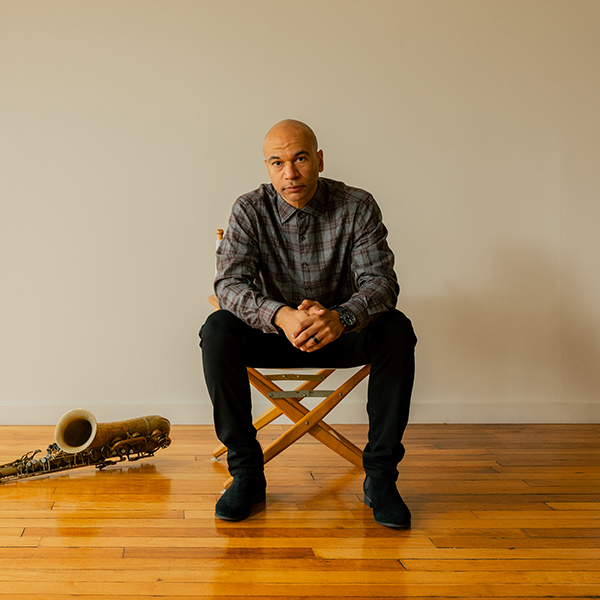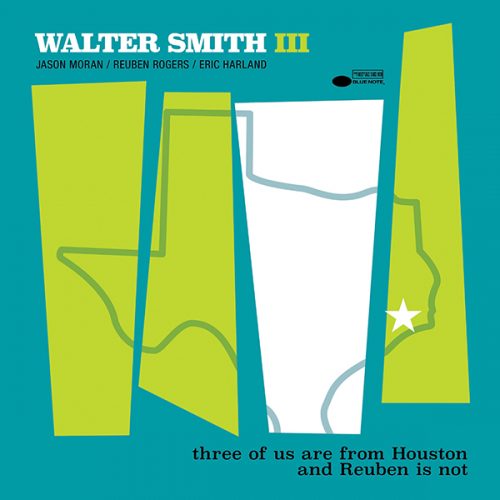September 27, 2024
By John Murph
Saxophonist Walter Smith III pays homage to his hometown of Houston, Texas on his sophomore Blue Note album, three of us are from Houston and Reuben is not. The album’s wry title signifies the lineup, which includes fellow Houston natives – pianist Jason Moran and drummer Eric Harland – while bassist Reuben Rogers, who hails from the Virgin Islands, rounds out the quartet. Together they enliven 10 compelling Smith originals and an imaginative rendering of a Sam Rivers composition – all of which speaks to Smith’s ascending status as one of modern jazz’s most engaging talents of his generation.
Smith explains that when he assembled the new quartet for the album, he noticed that three of the members were from Houston. “And Reuben is not,” he says with a laugh. “That informed the inspirations behind the compositions. At the end of the recording sessions, I was trying to come up with a name for the album and almost all my ideas were uninspired. But then I went to the first page of my album notes and said, ‘That’s it: three of us are from Houston and Reuben is not.’ It outlined the theme and personality of the band correctly.”
Moran and Harland are slightly older than Smith, yet they all attended Houston’s famed Kinder High School for the Performing and Visual Arts, a hotbed of young jazz talent where Smith and his classmates admired alumni who graduated before them and led world-renowned careers.
But for all the Houston ties, the impetus for the quartet began with Rogers in mind. “There’s something that he has in his playing that’s very different from other bassists of my generation,” Smith says before explaining that Rogers shows great respect for the framework of a composition, particularly when it comes to approaching chord changes. “He brings an old school approach to playing the bass – more groove oriented and melodic, but within the construct of what the song is.”
Smith was also attracted to Rogers’ interactions with Moran and Harland when the three played with saxophonist and fellow Blue Note artist, Charles Lloyd. Smith has played with all three members of this quartet previously in some capacities, but he was especially keen on Moran and Harland’s musical accord. He applauds Moran and Harland’s ability to create spontaneous, cogent music from a small amount of written material.
“It just feels like creativity with no judgment,” Smith says of their collaborative playing. “I can show up at a gig with just five notes on a page and say, ‘We have a 90-minute set.’ And they would be, ‘Alright! Let’s go.’ And they will make it work.”
With that mind, Smith purposely switched gears in terms of his compositional approach which differed from his previous Blue Note album return to casual. “I didn’t want to write material like I did for my last album on which I composed 10 or more revisions of the material. I spent a lot of time on that material, obsessing over each note and each measure of all the songs,” Smith says. “For the new compositions, I decided to write less so that everyone can get to the meat of the songs quicker.”
three of us are from Houston and Reuben is not opens with “Seesaw,” the first song Smith composed for the album and one of several he wrote specifically for his bandmates. The tune’s teetering ebullience alludes to the impact Moran and Harland had on Smith when he was still a high school student. “I was thinking about how I arrived at the decision to follow a career in music while weighing other options,” says Smith, explaining the reason behind the composition’s ricocheting, waltzing nature.
For Harland, Smith composed the hypnotic “610 Loop,” which consists of two sections within a cyclical form. The title alludes to the interstate freeway that circles Houston. Smith recalls when Harland was working with Betty Carter and the band came to Houston’s Wortham Theater Center to perform in 1995. That concert had an impact on Smith, who was then in the 10th grade. “That was my first time seeing and thinking about music and musicians not being local,” Smith says. “That’s when I realized that these musicians traveled all over the world. There was no internet or YouTube at that time. All we were doing was just buying CDs thinking that they all live in New York and only play in New York.”
As for Moran, Smith revamped his composition “Moranish” from his 2010 album, III (Criss Cross) and reimagined it as “Gangsterism on Moranish,” a nod to Moran’s series of “Gangsterism” compositions heard across the pianist’s Blue Note discography. Coincidently, Moran and Harland played on the 2010 version, while the refurbished one begins more abstractly before commencing the head-nod inducing groove of the original with Smith’s vaporous tenor saxophone passages wafting above Moran’s thick, restive piano accompaniment.
Smith also composed the album’s closing piece, “Lone Star” for Moran. The piano-saxophone duet originated from Smith’s observation that many people who don’t know Houston equate the city as being one filled with cowboys on the countryside instead of it being a culturally rich, diverse, multifaceted city. “After I wrote ‘Lone Star,’ I thought two things: either Jason is going to love it or he’s going to think it’s terrible,” Smith laughs. “When I presented it to him, Jason said, ‘That’s great! I play country shit like that.’ So, I was like, ‘Okay, we’re in.’”
The inspiration for the sanguine “Cézanne,” a beguiling piece with a slippery yet swinging rhythmic pulse, is not the French Post-Impressionist painter Paul Cézanne. It is instead a tribute to Cézanne, a once popular jazz club in Houston. “When I was in high school in the late-’90s, Cézanne was the spot where you could hear great music and it wasn’t background music; Cézanne was a listening room,” Smith says. “It was our Village Vanguard.”
“Misanthrope Hymn” is a pensive ballad with glassy rhythmic undertow that pays homage to his high school years when students took weekly vocabulary tests. One week, they had the word, “misanthrope,” which, Smith explains, was an apt description of a fellow high school classmate, who still goes by the nickname, Missy.
The plaintive ballad, “Office Party Music,” with its cinematic piano accompaniment and rhythmic sway, references a scene from the science fiction psychological thriller TV series Severance, involving a character who is awarded a 5-minute “defiant jazz” music dance experience by her supervisor. The bizarre, impromptu office party leads to an attack on supervisor by Dylan, a jealous, disgruntled fellow employee. “That scene was just funny to me,” Smith says. “I wrote the composition imagining a rescoring of that scene.”
The quicksilver “A Brief Madness” is another showcase for Smith and Moran’s sterling rapport. At first, the composition may sound like a spur-of-the-moment modern jazz excursion driven by a rapid-fire momentum, but a closer observation reveals that it’s an almost through-composed piece with Moran and Smith zipping through labyrinthine passages in unison. “‘A Brief Madness’ is about four or five pages long of just notes,” Smith explains. “But we take a few breaks in the middle where we just play in which the music gets a little wild.”
The album’s remaining two originals are the elliptical, Ornette Coleman-ish “24,” which contains fleeting beeping moments, signifying Smith pager code number when he was in high school; and the sumptuous ballad, “Montrose Nocturne,” an evocation of the Montrose’s art district where Smith’s high school alma mater was located.
The album’s sole non-original is “Point of Many Returns,” a free-bop Sam Rivers composition that was on the 1967 Blue Note LP, Contours, which Smith names as his favorite Rivers album. Smith’s interpretation takes on a meatier feel as well as more modern rhythmic pulse, thanks to Harland’s serrated drumming. Nevertheless, it retains the exploratory nature and bright melodicism of the original.
Smith says that the inspiration behind his makeover of “Point of Many Returns” arose from watching videos of Moran during the recording sessions for the pianist’s 2001 album Black Stars featuring Rivers. “Sam was playing piano; and it was just incredible watching him,” Smith recalls before mentioning that the first song he ever recorded was Rivers’ “Cyclic Episode” for his 2006 debut Casually Introducing Walter Smith III. It’s worth noting that the cover of that album was also an homage to the cover of Rivers’ own 1964 debut album Fuchsia Swing Song on Blue Note.
With three of us are from Houston and Reuben is not, Smith hopes to bring attention to the wider music world that Houston already had and continues to be a major U.S. cultural hub. “Texas isn’t only oil, guns, and politics,” Smith says. “There’s a thriving culturally rich community, which many people don’t think of when they picture Texas.”







